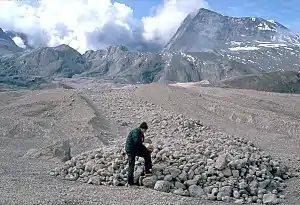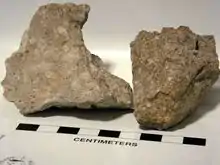Pyroclastic rock
Pyroclastic rocks (derived from the Greek: πῦρ, meaning fire; and κλαστός, meaning broken) are clastic rocks composed of rock fragments produced by explosive volcanism and erupted as individual particles. The individual rock fragments are known as pyroclasts. Pyroclastic rocks are a type of volcaniclastic deposit.[1][2] Phreatic pyroclastic deposits are a variety of pyroclastic rock that forms from the explosive interaction of magma with groundwater.[3]


Unconsolidated accumulations of pyroclastics are described as tephra. Tephra becomes volcaniclastic rock when it is lithified, which can occur immediately after emplacement due to welding from the residual heat of the tephra,[4] or much later from reactions with groundwater (diagenesis).[5]
One of the most spectacular types of pyroclastic deposit is an ignimbrite, which is the deposit of a ground-hugging pumiceous pyroclastic density current (a rapidly flowing hot suspension of pyroclasts in gas). Ignimbrites may be loose or weakly or intensely welded to solid rock, and they can bury entire landscapes. Ignimbrites are the only volcanic product with volumes rivaling those of flood basalts.[6]
Classification
Pyroclasts include juvenile pyroclasts derived from chilled magma, mixed with accidental pyroclasts, which are fragments of country rock. Pyroclasts of different sizes are classified (from smallest to largest) as volcanic ash, lapilli, or volcanic blocks (or, if they exhibits evidence of having been hot and molten during emplacement, volcanic bombs). All are considered to be pyroclastic because they were formed (fragmented) by volcanic explosivity, for example during explosive decompression, shear, thermal decrepitation, or by attrition and abrasion in a volcanic conduit, volcanic jet, or pyroclastic density current.[7]
| Clast size | Pyroclast | Mainly unconsolidated (tephra) | Mainly consolidated: pyroclastic rock |
|---|---|---|---|
| > 64 mm | block (angular) bomb (if fluidal-shaped) | blocks; agglomerate | pyroclastic breccia; agglomerate |
| < 64 mm | lapillus | lapilli | lapillistone (lapilli-tuff is where lapilli are supported within a matrix of tuff) |
| < 2 mm | coarse ash | coarse ash | coarse tuff |
| < 0.063 mm | fine ash | fine ash | fine tuff |
Two modes of transport can be distinguished: atmospheric eruption plumes, from which pyroclasts settle to form topography-draping pyroclastic fall layers, and by hot pyroclastic density currents (including pyroclastic flows and pyroclastic surges).[8]
During Plinian eruptions, pumice and ash are formed when silicic magma is fragmented in the volcanic conduit, because of decompression and the growth of bubbles. Pyroclasts are then entrained in a buoyant eruption column which can rise several kilometers into the stratosphere and cause aviation hazards.[9] Particles fall from atmospheric eruption plumes and accumulate as layers on the ground, which are described as fallout deposits.[10]
Pyroclastic density currents, may be either fully dilute (dilute, turbulent ash clouds, right down to their lower levels) or granular fluid based (the lower levels of which comprise a concentrated dispersion of interacting pyroclasts and partly trapped gas).[11] The former type are sometimes called pyroclastic surges (even though they may be sustained rather than "surging") and the latter may be termed pyroclastic flows (these, also, can be sustained and quasi steady or surging). As they travel, pyroclastic density currents deposit particles on the ground, and they entrain cold atmospheric air, which is then heated and thermally expands.[12] Where the density current becomes sufficiently dilute to loft, it rises into the atmosphere as a phoenix plume[13] (or co-PDC plume).[14] These phoenix plumes typically deposit thin ashfall layers that may contain little pellets of aggregated fine ash.[15]
Hawaiian eruptions such as those at Kīlauea can eject an upward-directed jet of hot droplets and clots of magma suspended in gas; this is called a lava fountain[16] or fire-fountain.[17] If sufficiently hot and liquid when they land, the hot droplets and clots of magma may agglutinate to form spatter (agglutinate), or fully coalesce to form a clastogenic lava flow.[16][17]
See also
- Silicon dioxide
- Hyaloclastite – A volcaniclastic accumulation or breccia
- Peperite – Sedimentary rock that contains fragments of younger igneous material
- Scoria – Dark vesicular volcanic rock
References
- Fisher, Richard V. (1961). "Proposed classification of volcaniclastic sediments and rocks". Geological Society of America Bulletin. 72 (9): 1409. doi:10.1130/0016-7606(1961)72[1409:PCOVSA]2.0.CO;2.
- Fisher, Richard V.; Schmincke, H.-U. (1984). Pyroclastic rocks. Berlin: Springer-Verlag. ISBN 3540127569.
- Fisher 1961, p. 1409.
- Fisher & Schmincke 1984, p. 285.
- Schmincke, Hans-Ulrich (2003). Volcanism. Berlin: Springer. p. 138. ISBN 9783540436508.
- Philpotts, Anthony R.; Ague, Jay J. (2009). Principles of igneous and metamorphic petrology (2nd ed.). Cambridge, UK: Cambridge University Press. p. 77. ISBN 9780521880060.
- Heiken, G. and Wohletz, K., 1985 Volcanic Ash, University of California Press;, pp. 246.
- Philpotts & Ague 2009, p. 73.
- Schmincke 2003, pp. 155-176.
- Fisher, Schmincke & 19084, p. 8.
- Breard, Eric C.P.; Lube, Gert (January 2017). "Inside pyroclastic density currents – uncovering the enigmatic flow structure and transport behaviour in large-scale experiments". Earth and Planetary Science Letters. 458: 22–36. doi:10.1016/j.epsl.2016.10.016.
- Schmincke 2004, pp. 177-208.
- Sulpizio, Roberto; Dellino, Pierfrancesco (2008). "Chapter 2 Sedimentology, Depositional Mechanisms and Pulsating Behaviour of Pyroclastic Density Currents". Developments in Volcanology. 10: 57–96. doi:10.1016/S1871-644X(07)00002-2.
- Engwell, S.; Eychenne, J. (2016). "Contribution of Fine Ash to the Atmosphere From Plumes Associated With Pyroclastic Density Currents". Volcanic Ash: 67–85. doi:10.1016/B978-0-08-100405-0.00007-0.
- Colombier, Mathieu; Mueller, Sebastian B.; Kueppers, Ulrich; Scheu, Bettina; Delmelle, Pierre; Cimarelli, Corrado; Cronin, Shane J.; Brown, Richard J.; Tost, Manuela; Dingwell, Donald B. (July 2019). "Diversity of soluble salt concentrations on volcanic ash aggregates from a variety of eruption types and deposits". Bulletin of Volcanology. 81 (7): 39. doi:10.1007/s00445-019-1302-0.
- Macdonald, Gordon A.; Abbott, Agatin T.; Peterson, Frank L. (1983). Volcanoes in the sea : the geology of Hawaii (2nd ed.). Honolulu: University of Hawaii Press. pp. 6, 9, 96–97. ISBN 0824808320.
- Allaby, Michael, ed. (2013). "Fire-fountain". A dictionary of geology and earth sciences (Fourth ed.). Oxford University Press. ISBN 9780199653065.
Other reading
- Blatt, Harvey and Robert J. Tracy (1996) Petrology: Igneous, Sedimentary, and Metamorphic, W.H.W. Freeman & Company; 2nd ed., pp. 26–29; ISBN 0-7167-2438-3
- Branney, M.J., Brown, R.J. and Calder, E. (2020) Pyroclastic Rocks. In: Elias, S. and Alderton D. (eds) Encyclopedia of Geology. 2nd Edition. Elsevier. ISBN 9780081029084
| Wikimedia Commons has media related to Pyroclastic rocks. |